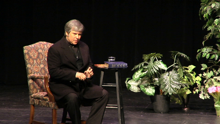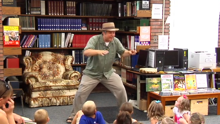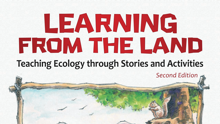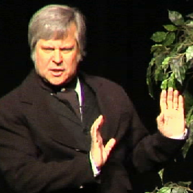Folklore and Geography
A lesson plan to help students write and tell landform stories.
by Brian "Fox" Ellis, Green Teacher Winter 2000
Throughout the world people tell stories of how things came to be. Mysterious mountains, unusually deep canyons and precipitous cliffs are pregnant with stories of adventure, failure, and triumph. The Dine, or Navajo, say that the landscape stalks us with stories. These stories remind us of our place in the world; that cliff or this boulder reminds us of our relationship with others, of the right way to walk in this world. The Aborigines of the Australian Outback use stories as maps to help them find their way in that bleak landscape. The stories are told at a walking pace as they cross the land. As features of the landscape come into view they are reminded of the next chapter in the story; and as the story unfolds they are reminded of which way to turn to get to the next watering hole, the next village or wherever the chosen story leads.
These stories can be powerful tools for teachers who want to bring geography to life. Although they are considered fiction or folklore, many of them contain scientifically accurate interpretations of geological processes. Case in point: in the Shawnee version of the creation of Turtle Island, or North America, the continent is shaped like a turtle and it is swimming in the ocean. It takes very little imagination to see Florida and Baja California as hind legs and Mexico as a tail. Alaska and Nova Scotia are peninsulas, or front legs, and Greenland is the head. The truth is that north America is moving like a turtle, slowly, drifting five to six centimeters per year. Another example: In the Hawaiian creation story, the Earth Goddess belches fire and gives birth to Pele, the Goddess of the Volcano. Indeed, the Hawaiian Islands are volcanic eruptions from the earth's underwater crust.
These stories can make flat maps multidimensional, adding drama and suspense to the study of geography and geology. Such stories also add multicultural dimensions to the teaching of geography. This is especially pertinent if you are teaching an ethnically diverse class and can include stories from students' cultures to enhance the teaching of the continent.
Reading the Landscape
Begin the unit with a brief discussion of common lsandforms and how they are made. The following list, while in no way complete, will serve as an introduction.
-
Types of Landforms Causes
-
Hills Erosion
-
Volcanoes Wind
-
Mountains Water
-
Valleys Plate tectonics
-
Plateaus
-
Rivers Glacial carving and moraines
-
Plains Faults—Earthquakes
-
Bays
-
Canyons
-
Islands
Also introduce map vocabulary terms such as elevation, latitude and longitude, and color-coded keys. To make these ideas graphic and to give kinesthetic learners a hands-on opportunity to create topographical maps, invite the class to do one or both of the following activities.
Knuckle Mountain Objectives:
-
Students will gain a hands-on understanding of topographical maps.
-
Students will learn basic cartography skills.
-
Students will improve their visual-spatial thinking ability.
Materials:
Procedure:
Ball one hand into a fist and lay it flat on a table or desk. Next, draw concentric circles on your knuckles, moving down in elevation approximately one centimeter with each circle. The first circle will be a small irregular oval around the tallest knuckle. Moving down about one centimeter, draw a second oval that includes two or three knuckles. Draw a third, fourth, and fifth oval, each time moving one centimeter lower on the topography of your fist. You will notice that steep places will have lines closer together, less steep places have lines further apart, the gaps between fingers will be inverted V's, and if you have bony hands or large blood veins you will see little U's on the back of your hand. After drawing the lines on your fist, flatten your hand on the table and you will see a two dimensional topographical map that approximates the three-dimensional Knuckle Mountain.
Demonstrate this for the students and then draw your topographical map on the chalkboard or overhead projector. Discuss water drainage, elevation changes, how the proximity of lines relates to steepness, thus capturing three dimensions on a flat page.
Ask students to draw lines on their fists, flatten their hands and then copy the topographical map of their Knuckle Mountain on a piece of paper. Student could then color-code their topographical maps and make a key to explain the colors. To further their understanding of three-dimensional thinking, students could also draw a mural of Knuckle Mountain based on the reading of their topographical maps. What would this mountain look like from the south? From the northeast?
Underwater Mountains
Objectives:
-
Students will gain a hands-on understanding of topographical maps.
-
Students will learn basic cartography skills.
-
Students will improve their visual-spatial thinking ability.
Materials:
Procedure:
This is an activity that students can perform individually or in small cooperative groups of two to four students. The advantage of group work is that they ensure each other's accuracy and you need fewer sets of materials.
Instruct students to carefully measure the depth of the bowl and draw notches every one centimeter on the inside of it. Ask them to carefully place the pointed stone in the bottom of the bowl and then pour one centimeter of water into the bowl. Have each group of students draw the shape of their stone at the water line. The students then fill the bowl to the next one-centimeter increment and again draw the shape of the stone at the water line. Ask them to repeat this process until only a small tip of the rock protrudes from the water. Their maps will be a series of concentric circles. Students could then color code their topographical maps and make a key to explain the colors.
Each group now has a topographical map of their stone. This could be a springboard for discussions of scale, volcanoes as underwater mountains, altitudes above and below sea level, ways in which actual mountain maps and sea floor maps are drawn, and the reading of real topographical maps. As a test of the efficacy of their maps, have each group trade maps with a group who used a different stone. Using only the map, have them draw the stone it depicts. When everyone is finished, place the stones on a central table and ask students to try to match their own drawings and their partners' maps with the correct stone.
Telling and Writing Landform Stories
Once students have a basic understanding of topographical maps and landforms, introduce landform stories from various cultures. Discuss, for example, Paul Bunyan, Pele the Fire Goddess, Turtle Island, Sleeping Bear Dunes, Devil's Tower, and other landform stories they may know (see the bibliography below). Tell the story of "The Twin Sisters," "Coyote Dances with the Stars," "Grandma Turtle," or one of your favorite stories of landforms. After telling the story discuss the facts and the fiction within the story. Which parts are scientifically accurate? Which are fictional? What could we learn from this story about the creation of landforms? What could we learn from the culture depicted in the story?
Pass out detailed topographical maps of your region, country or the world. Challenge students to choose an actual landform on the map such as a river valley or mountain, and draw a picture of it based on their translation of the two-dimensional map representation into a three-dimensional landform. Ask them to hypothesize about the geological processes that created this landform as they draw. They could also begin to daydream about stories in which they would explain this formation.
Using the "Prior Knowledge Quiz," challenge students to brainstorm the details of their creation myth. You may want to begin with the questions about setting and then ask the questions about characters. Ask students to close their eyes and, using their answers to the questions as the raw materials, daydream a vivid, virtual-reality version of their story. Tell them to make it up as they go along, as if they are watching a movie inside their forehead. When they open their eyes, ask them to turn to a partner and take turns telling their stories. Writing is always clearer and more succinct if students first tell it and then write it.
After students have a rough draft of their stories, assist them in researching the scientific facts about their landforms, focusing on the geological processes that actually shaped their piece of the geological processes that actually shaped their piece of the Earth. As an incentive, offer bonus points for weaving this scientific information into their story as they rewrite their creation myths.
When the stories are finished, each student could create a topographical map of their landform as well as a mural of their story with the canyon, mountain or island in the background. These could be bound together as a classroom collection of short stories or mounted on a bulletin board. Students could also perform their stories for their class.
Recommended Reading
The Way to Make Perfect Mountains by Byrd Baylor, illustrated by Leonard F. Chana. [El Paso, TX: Cinco Puntos Press, (800) 566-9072, 1997, ISBN 0-938317-26-11997, 62pp].
Beautifully erasing boundaries between science and mythology, Byrd Baylor uses finely crafted poetry to illuminate the mountains of the southwest desert. With an emphasis on magic and mystery, she retells Native American legends of Sacred Mountains that she has collected from her neighbors and literary sources. The unique stippling method of the illustrator could be used to teach the students a new form of landscape illustration.
Between Earth and Sky: Legends of Native American Sacred Places by Joseph Bruchac, illustrated by Thomas Locker [New York: Harcourt, 1996, ISBN 0-15-200042-9, 32pp].
Featuring famous North American landmarks like the Grand Canyon and Niagara Falls, Bruchac briefly retells the Native American legends of several unique geological formations. Locker's glorious oil paintings are reminiscent of the Hudson river School of Art, which celebrated the wild landscapes of America at the turn of the century. These brief retellings could easily be researched and elaborated into dramatic performance material or rewritten as myths that have an emphasis on science.
Dear Katie, The Volcano Is a Girl by Jean Craighead George, illustrated by Daniel Powers [New York: Hyperion Books, 1998, ISBN 0-7868-0314-2, 32pp; U.S. distributor (800) 759-0190, Can. distributor (800) 267-3366].
This is the perfect example of mythology-meets-science in a beautifully illustrated children's book. Through a fictional dialogue between a scientific grandmother and a little girls who believes in the mythology of Pele, the Fire Goddess of Hawaii, the reader sees the validity of both points of view. The illustrator even went so far as to include a mystical goddess prompting the scientific schematic drawings of how volcanoes are made.
The Legend of Sleeping Bear by Kathy-jo Wargin, illustrated by Gijsbert van Frankenhuyzen [Chelsea, Michigan: Sleeping Bear Press, (734) 475-4411, 1998, ISBN 1-886947-35-X, 42pp].
A forest fire in Wisconsin forces a mother bear and her two cubs to swim across Lake Michigan. The cubs do not make it, leaving the mother to grieve upon the Michigan shore, forming Sleeping Bear Dunes. The cubs become North and South Manitou Islands. The illustrator earns extra points for scientific accuracy in his realistic renderings of the plant and animal life. He even included a map in the end papers. This Ojibwa story is well told, if a bit flowery. It could be a stronger example of a landscape story with just a sentence or two about the sand deposition from glacial times in the formation of these islands and sand dunes.
Where Legends Live: A Pictorial Guide to Cherokee Mythic Places by Douglas A. Rossman, illustrated by Nancy-Lou Patterson [Cherokee, NC: Cherokee Publications (828) 488-8856, 1988, ISBN 0-935741-10-0, 48pp].
With black and white photos, extensive site descriptions and a keyed map, this is the ultimate field guide to the mythic places of the Cherokee homeland. The author gives only a brief synopsis of each story, but recommends James Mooney's Myths of the Cherokee for a more complete version. If every region of the country had a book like this, we would have a much richer relationship with the mythos of our home and a much deeper sense of place.









